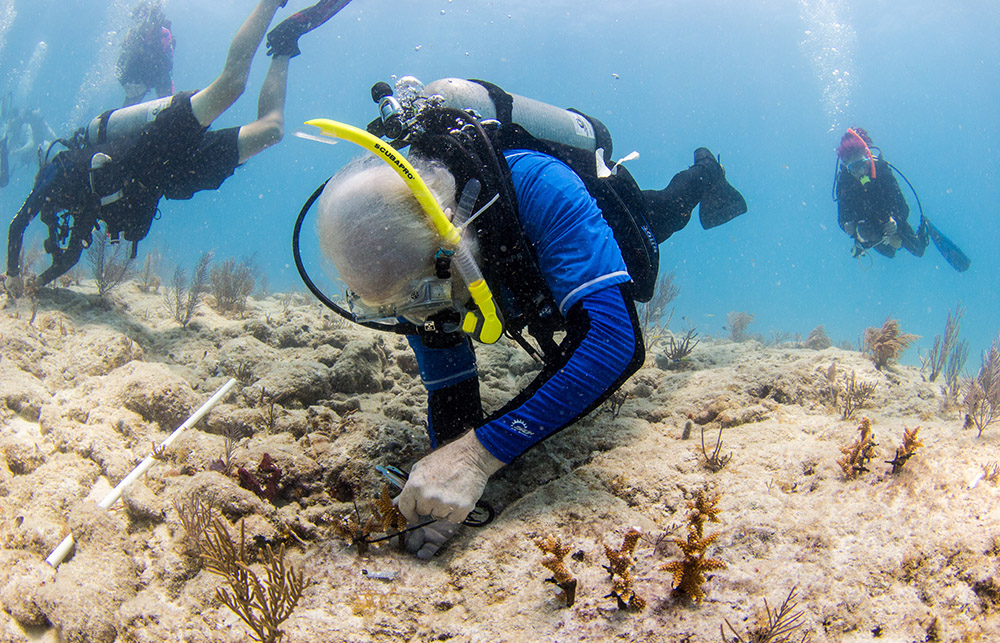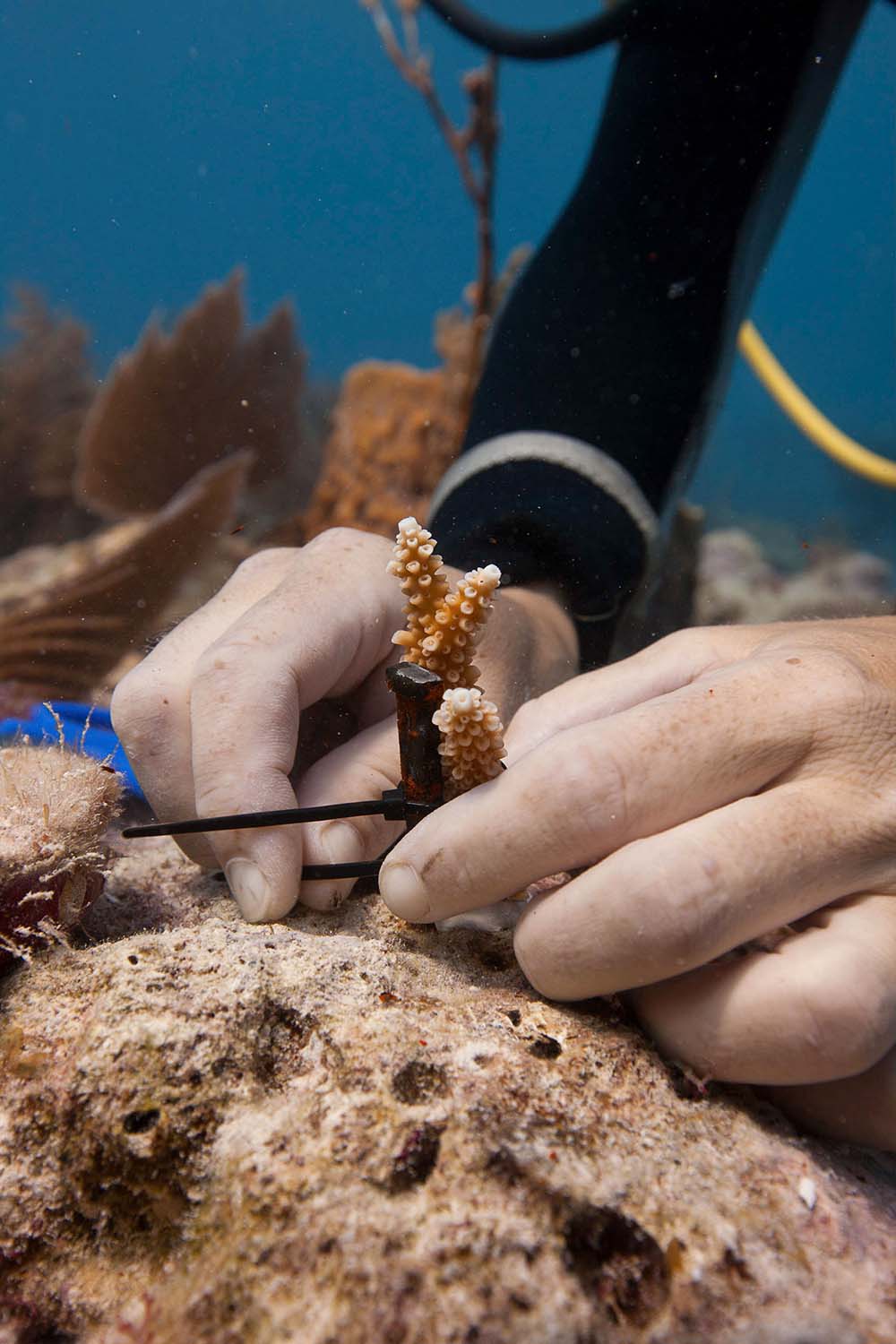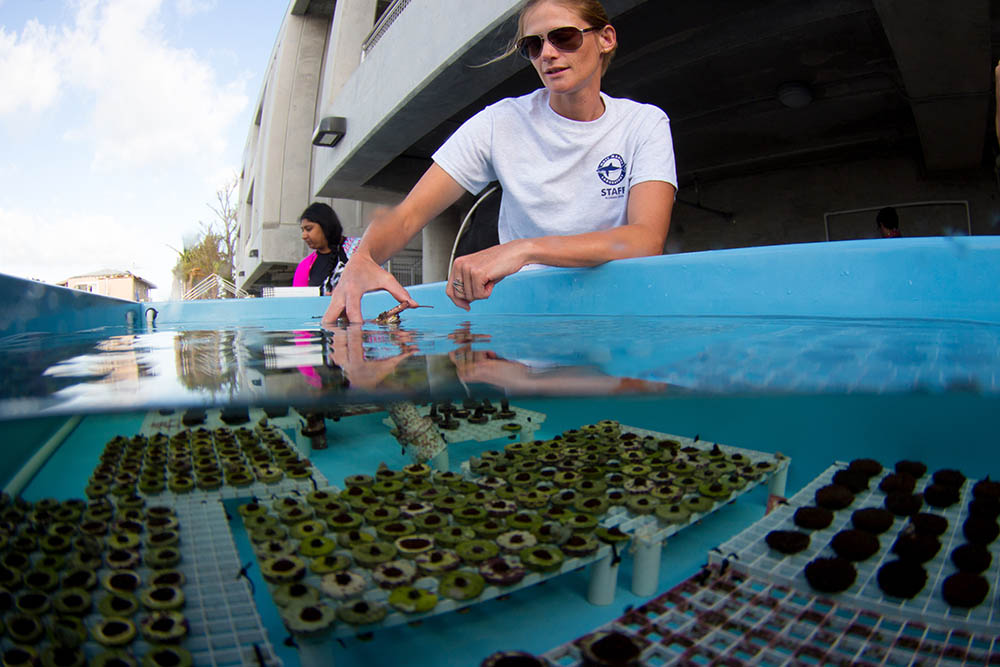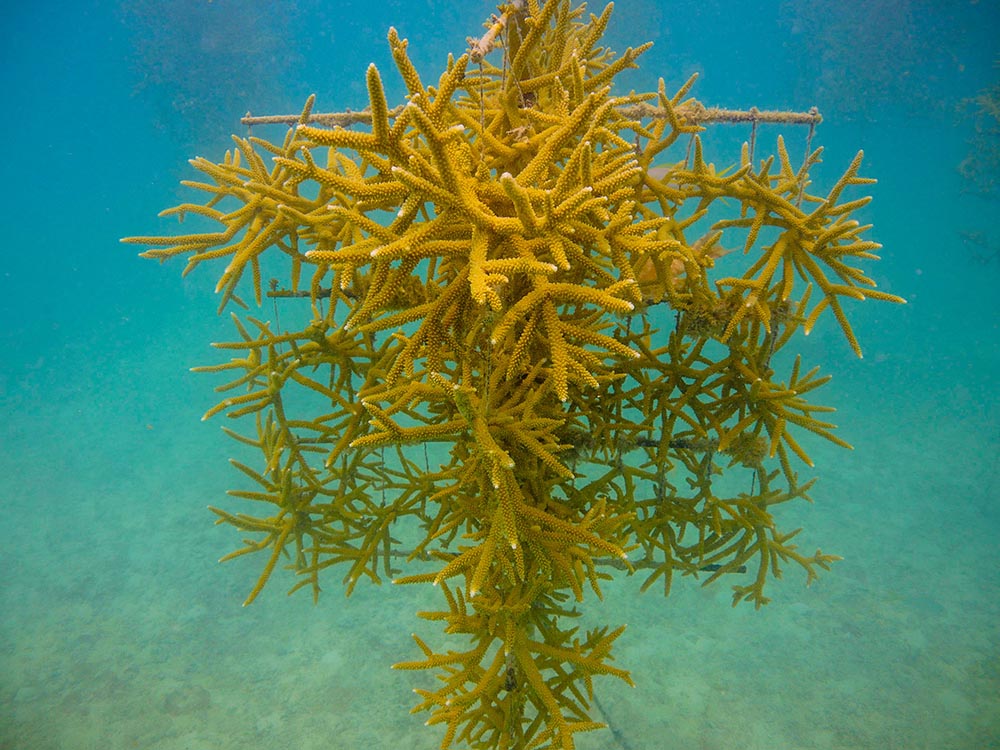
八月满月后的一至七个夜晚,午夜过后的几个小时,是佛罗里达珊瑚的繁殖时期。
珊瑚具有产卵同步性,它们释放出卵子和精子,流向星光照耀的海面。“这简直就像一场水下暴风雪。”经常观察珊瑚繁殖的艾莉森·德拉什米特描述道。艾莉森是莫特海洋实验室(Mote Marine Lab)伊丽莎白摩尔国际珊瑚礁研究与修复中心(Elizabeth Moore International Center for Coral Reef Research & Restoration)的运营主任,该中心位于佛罗里达礁岛群著名的七英里大桥(Seven Mile Bridge)的南侧。
许多“科学家、志愿者和任何拥有船只的人都愿意在半夜等待这一奇观发生”,德拉什米特就是其中一位。但在她看来,这种一年一度的珊瑚繁殖现象虽然美丽,但效率却极低。卵子和精子在海面散开后,精子有20分钟的时间与卵子相遇并使其受精。受精卵成熟的几率约为百万分之一,也就是每25年成功一次。这是生长相对健康的珊瑚礁的情况。
然而,从大陆延伸到基韦斯特的佛罗里达珊瑚礁并不健康。2014年,迈阿密外一项疏浚工程被认定引发了细菌传染,导致珊瑚感染了“石珊瑚组织损失症”( Stony Coral Tissue Loss)这一细菌疫病,再加上海水变暖,这里98%到99%的珊瑚礁已经白化,科学家称其为功能性灭绝。繁殖能力强的健康珊瑚没有达到临界密度,在自然环境下受精变得极其困难。德拉什米特说:“所以我们必须帮助大自然母亲摆脱困境。”没有人类的干预,没有科学指导和技术支持,佛罗里达珊瑚礁将无法存活下去。
使用环氧树脂和钉子将健康的苗圃珊瑚出圃种植在佛罗里达大松礁岛近海的出圃种植基地。

虽然莫特的团队8月仍然在夜间工作,他们用网收集珊瑚精子和卵子,并迅速送回实验室进行受精,但这种方式也可能是低效的。因为在8月的佛罗里达,夜间的雷雨比迪士尼乐园飞溅山水道上的水花来得更靠谱。“如果因为暴风雨的冲击而错过一个晚上,那么你就错过了整整一年的新遗传物质。”德拉什米特这样说道。
为了避免这些无法控制的风险,莫特的团队开始运用一种新方法——水池繁殖。在建筑内外是混凝土做成的分层实验室,可以抵御暴风的侵袭,汩汩作响的浅底水池培养着多达5万个珊瑚宝宝,它们生长在厨柜把手大小的水泥塞里。这些珊瑚碎片是用一种名为微断裂的方法从健康的珊瑚上切割下来的。
德拉什米特表示,“切割激活了生长反应,所以它们的生长速度比在自然环境下快50到60倍。”当这些珊瑚的直径达到大约3厘米时,潜水队就会把它们移植到珊瑚礁的一个死亡珊瑚头上。“我们会钻出圆形的类似意大利辣香肠比萨样式的洞,把水泥塞塞进那些洞里,珊瑚就会迅速生长在死亡珊瑚头上。”

并不是所有珊瑚都会被放到珊瑚礁上,有些仍然留在实验室作为繁殖的母群体。这一工作由汉娜·科赫博士和生物学家科迪·恩格尔斯玛领导。一个大型水箱里,装满了从实验室外面的运河抽来的水,“我们能够控制各项条件,使珊瑚按照我们的时间表而不是它们自己的时间产卵。” 德拉什米特说道。加热器可以让水保持理想的温度,灯光模仿满月的浪漫光辉,这样浪漫的场景布置,就差一瓶红酒了。除了8月的自然产卵,团队计划启动一个从2022年开始的春季产卵周期,确保有大量受精卵能够在实验室里培养,最终被移植到珊瑚礁上。
莫特和其他海洋实验室已经在珊瑚礁修复方面取得有希望的成果,但面对气候变化,德拉什米特承认,“这不是救世主,而是创可贴。仅仅做修复是不够的,所以我们正在很努力地从研究层面进行探索。”这也是考特尼·克莱帕克博士所做的事情。
克莱帕克称:“我正在寻找可以适应海洋变暖和气候变化的珊瑚,或者天生具有更高的耐热性,能够在这种环境生存下去的珊瑚。”
我们可以做一个类比。一位种苹果的农民想看看自己的土地是否最适合种澳洲青苹果、富士苹果或嘎拉苹果。在选择了最合适的品种后,比如富士苹果,她能够在她的富士果园中选择最强壮、最美味、最能抗虫害的果树,并将它们嫁接到新的标本上。不管是苹果、拉布拉多德利犬还是珊瑚,原理都是一样的,即选择性繁殖。并没有经过几代人的努力,莫特海洋实验室将这一过程缩短到了两个月的时间。克莱帕克博士通过她在欧道明大学(Old Dominion University)与人合作开发的自动计算机控制系统——珊瑚漂白自动应力系统(Coral Bleaching Automated Stress System),将这一过程进一步加速。该系统处理标本仅需一天时间。
克莱帕克表示,“海洋夏季最高温度平均约为80华氏度,所以基于本世纪末的温度预测,我们一直以86华氏度至87华氏度的温度对珊瑚进行应力测试。”她测量珊瑚的蛋白质水平、密度、珊瑚共生藻类的光合生产力以及其他因素,“此外,我非常高兴可以贡献给莫特海洋实验室的是我研究基因表达的分子实验。通过实验,生理学能够告诉我珊瑚的感受,但遗传学可以给我生理学的先兆,完成应力反应的图像。”例如,当一片摩羯鹿角珊瑚(鹿角珊瑚)的生理数据显示其应力小于另一片时,“我能够看看这种耐力是否有任何遗传标记。”

进入莫特海洋实验室基因库的是强壮的标本。“如果我可以告诉[科赫和恩格尔斯玛]哪一种珊瑚基因更好,她们就能够专注于培育更强壮的珊瑚,然后我们就可以继续繁殖那些所谓更强壮的珊瑚,这类珊瑚拥有在长期气候变化中最有希望生存下来的机制。最终,某种辅助进化的高潮就会到来。”克莱帕克这样说道。
辅助进化这个词听起来的确有点多管闲事。是人类导致了这个问题,所以必须解决它,特别是面对一个未来越来越不适合居住的海洋。德拉什米特说:“珊瑚礁是佛罗里达州最珍贵的东西,实际上对美国也很重要,但是这些珊瑚礁并不能够自己自然恢复。人类需要迅速干预,给珊瑚礁一个过渡期,让它们可以经过努力生存下去。”
译者:郝秀
审校:汪皓
八月满月后的一至七个夜晚,午夜过后的几个小时,是佛罗里达珊瑚的繁殖时期。
珊瑚具有产卵同步性,它们释放出卵子和精子,流向星光照耀的海面。“这简直就像一场水下暴风雪。”经常观察珊瑚繁殖的艾莉森·德拉什米特描述道。艾莉森是莫特海洋实验室(Mote Marine Lab)伊丽莎白摩尔国际珊瑚礁研究与修复中心(Elizabeth Moore International Center for Coral Reef Research & Restoration)的运营主任,该中心位于佛罗里达礁岛群著名的七英里大桥(Seven Mile Bridge)的南侧。
许多“科学家、志愿者和任何拥有船只的人都愿意在半夜等待这一奇观发生”,德拉什米特就是其中一位。但在她看来,这种一年一度的珊瑚繁殖现象虽然美丽,但效率却极低。卵子和精子在海面散开后,精子有20分钟的时间与卵子相遇并使其受精。受精卵成熟的几率约为百万分之一,也就是每25年成功一次。这是生长相对健康的珊瑚礁的情况。
然而,从大陆延伸到基韦斯特的佛罗里达珊瑚礁并不健康。2014年,迈阿密外一项疏浚工程被认定引发了细菌传染,导致珊瑚感染了“石珊瑚组织损失症”( Stony Coral Tissue Loss)这一细菌疫病,再加上海水变暖,这里98%到99%的珊瑚礁已经白化,科学家称其为功能性灭绝。繁殖能力强的健康珊瑚没有达到临界密度,在自然环境下受精变得极其困难。德拉什米特说:“所以我们必须帮助大自然母亲摆脱困境。”没有人类的干预,没有科学指导和技术支持,佛罗里达珊瑚礁将无法存活下去。
使用环氧树脂和钉子将健康的苗圃珊瑚出圃种植在佛罗里达大松礁岛近海的出圃种植基地。
虽然莫特的团队8月仍然在夜间工作,他们用网收集珊瑚精子和卵子,并迅速送回实验室进行受精,但这种方式也可能是低效的。因为在8月的佛罗里达,夜间的雷雨比迪士尼乐园飞溅山水道上的水花来得更靠谱。“如果因为暴风雨的冲击而错过一个晚上,那么你就错过了整整一年的新遗传物质。”德拉什米特这样说道。
为了避免这些无法控制的风险,莫特的团队开始运用一种新方法——水池繁殖。在建筑内外是混凝土做成的分层实验室,可以抵御暴风的侵袭,汩汩作响的浅底水池培养着多达5万个珊瑚宝宝,它们生长在厨柜把手大小的水泥塞里。这些珊瑚碎片是用一种名为微断裂的方法从健康的珊瑚上切割下来的。
德拉什米特表示,“切割激活了生长反应,所以它们的生长速度比在自然环境下快50到60倍。”当这些珊瑚的直径达到大约3厘米时,潜水队就会把它们移植到珊瑚礁的一个死亡珊瑚头上。“我们会钻出圆形的类似意大利辣香肠比萨样式的洞,把水泥塞塞进那些洞里,珊瑚就会迅速生长在死亡珊瑚头上。”
并不是所有珊瑚都会被放到珊瑚礁上,有些仍然留在实验室作为繁殖的母群体。这一工作由汉娜·科赫博士和生物学家科迪·恩格尔斯玛领导。一个大型水箱里,装满了从实验室外面的运河抽来的水,“我们能够控制各项条件,使珊瑚按照我们的时间表而不是它们自己的时间产卵。” 德拉什米特说道。加热器可以让水保持理想的温度,灯光模仿满月的浪漫光辉,这样浪漫的场景布置,就差一瓶红酒了。除了8月的自然产卵,团队计划启动一个从2022年开始的春季产卵周期,确保有大量受精卵能够在实验室里培养,最终被移植到珊瑚礁上。
莫特和其他海洋实验室已经在珊瑚礁修复方面取得有希望的成果,但面对气候变化,德拉什米特承认,“这不是救世主,而是创可贴。仅仅做修复是不够的,所以我们正在很努力地从研究层面进行探索。”这也是考特尼·克莱帕克博士所做的事情。
克莱帕克称:“我正在寻找可以适应海洋变暖和气候变化的珊瑚,或者天生具有更高的耐热性,能够在这种环境生存下去的珊瑚。”
我们可以做一个类比。一位种苹果的农民想看看自己的土地是否最适合种澳洲青苹果、富士苹果或嘎拉苹果。在选择了最合适的品种后,比如富士苹果,她能够在她的富士果园中选择最强壮、最美味、最能抗虫害的果树,并将它们嫁接到新的标本上。不管是苹果、拉布拉多德利犬还是珊瑚,原理都是一样的,即选择性繁殖。并没有经过几代人的努力,莫特海洋实验室将这一过程缩短到了两个月的时间。克莱帕克博士通过她在欧道明大学(Old Dominion University)与人合作开发的自动计算机控制系统——珊瑚漂白自动应力系统(Coral Bleaching Automated Stress System),将这一过程进一步加速。该系统处理标本仅需一天时间。
克莱帕克表示,“海洋夏季最高温度平均约为80华氏度,所以基于本世纪末的温度预测,我们一直以86华氏度至87华氏度的温度对珊瑚进行应力测试。”她测量珊瑚的蛋白质水平、密度、珊瑚共生藻类的光合生产力以及其他因素,“此外,我非常高兴可以贡献给莫特海洋实验室的是我研究基因表达的分子实验。通过实验,生理学能够告诉我珊瑚的感受,但遗传学可以给我生理学的先兆,完成应力反应的图像。”例如,当一片摩羯鹿角珊瑚(鹿角珊瑚)的生理数据显示其应力小于另一片时,“我能够看看这种耐力是否有任何遗传标记。”
进入莫特海洋实验室基因库的是强壮的标本。“如果我可以告诉[科赫和恩格尔斯玛]哪一种珊瑚基因更好,她们就能够专注于培育更强壮的珊瑚,然后我们就可以继续繁殖那些所谓更强壮的珊瑚,这类珊瑚拥有在长期气候变化中最有希望生存下来的机制。最终,某种辅助进化的高潮就会到来。”克莱帕克这样说道。
辅助进化这个词听起来的确有点多管闲事。是人类导致了这个问题,所以必须解决它,特别是面对一个未来越来越不适合居住的海洋。德拉什米特说:“珊瑚礁是佛罗里达州最珍贵的东西,实际上对美国也很重要,但是这些珊瑚礁并不能够自己自然恢复。人类需要迅速干预,给珊瑚礁一个过渡期,让它们可以经过努力生存下去。”
译者:郝秀
审校:汪皓
A couple hours after midnight, one to seven nights after the August full moon, Florida coral are in the mood.
With a swimmer’s synchronicity, they release their eggs and sperm, which stream toward the starlit surface, “like reverse snow happening in the water,” as described by frequent coral spawning observer Allison Delashmit, the director of operations for Mote Marine Lab’s Elizabeth Moore International Center for Coral Reef Research & Restoration on Summerland Key, on the south side of the Keys’ famous Seven Mile Bridge.
From Delashmit’s perspective, amid a flotilla of “scientists, volunteers, and anyone with a boat that was willing to sit out in the middle of the night and wait for this event to happen,” the annual phenomenon is beautiful, but incredibly inefficient. When the bundles of eggs and sperm detonate on the surface, the latter has 20 minutes to reach and fertilize the former. Chances of a fertilized egg reaching maturity is about one in a million. Every 25 years. That’s in a relatively healthy reef.
The Florida reef, which stretches from the upper mainland to Key West, is not a healthy reef. Stemming from a 2014 infection thought to originate from a dredging project outside Miami, the bacterial blight of Stony Coral Tissue Loss disease coupled with warming seas has left the reef 98% to 99% bleached, a state scientists call functional extinction. Absent a critical density of fit, reproductively capable coral, fertilization in the wild becomes extremely difficult. “So we have to help Mother Nature out,” Delashmit says. Without human intervention, guided by science and supported by tech, the Florida reef won’t survive.
While the Mote team still does the August overnight shifts, collecting the sperm and eggs in a net and quickly transporting them back to the lab for fertilization, that can also be inefficient—because if there’s one thing more reliable in Florida in August than tantrums in line at Splash Mountain, it’s nighttime thunderstorms. “And if you miss your one night because you’re run off the water by a storm,” Delashmit says, “then you’ve missed a whole year of new genetic material.”
To hedge against these uncontrollable elements, Mote has started a new process of tank-spawning. Inside and outside the building, a hurricane-proof concrete lasagna of laboratories, shallow, burbling tanks support up to 50,000 coral babies growing cement plugs the size of kitchen cabinet knobs. These pieces are cut from healthy coral in a method called microfragmentation.
“Cutting activates a growth response, so these grow 50 to 60 times faster than they would naturally in the wild,” Delashmit says. When these animals reach roughly three centimeters in diameter, the dive team transports them to a dead coral head on the reef. “We drill holes in a circular, pepperoni-pizza pattern, stick the plugs in those holes, and the coral quickly grows onto the dead coral head.”
Not all of the animals head to the reef. Some remain at the lab as parent colonies for reproduction led by Dr. Hanna Koch and biologist Cody Engelsma. In a large aquarium filled with water pumped from the canal outside the lab, “we are going to be able to manipulate conditions to what we need them to be for the corals to spawn on our schedule and not their own,” Delashmit says. Heaters maintain the ideal water temperature. Lights mimic the romantic glow of the full moon. These coral get everything but a bottle of wine. In addition to the natural spawning in August, the plan is to trigger a spring cycle starting in 2022, guaranteeing a healthy crop of fertilized eggs that can be raised in the lab and eventually, transplanted out to the reef.
Mote and other marine labs have seen promising results with reef restoration, but in the face of climate change, Delashmit admits, “It’s not a savior, it’s a Band-Aid. Doing restoration is not enough, so we’re really trying to dig into the research side of things,” which is where Dr. Courtney Klepac comes in.
“I'm looking for corals that can keep the pace with ocean warming and climate change or that have a naturally inherently higher tolerance that [will allow them to] survive,” Klepac says.
For comparison’s sake, consider an apple farmer who wants to see if her land is best suited for growing Granny Smith, Fuji, or Gala apples. After selecting the best performer—say, the Fuji—she can select the strongest, tastiest, most pest-resistant trees in her Fuji orchard and graft them into new specimens. Whether apples or Labradoodles or coral, the principle is the same: selective breeding. But instead of doing this over generations, Mote has sped up the process to two months. Klepac has accelerated it even further through a computer-controlled automatic system she co-developed while at Old Dominion University, the Coral Bleaching Automated Stress System (CBASS), which processes specimens in one-day experiments.
“The summertime maximum [ocean temperature] average is about 80 degrees, so we’ve been stressing our corals at 86, almost 87 degrees, based on end-of-century predictions,” Klepac says. She measures protein levels, density, photosynthesis productivity of coral’s symbiotic algae, and other factors, “and then the other side that, which I'm excited to bring to MOAT, is my molecular work where I look at gene expression. After an experiment, the physiology can tell me what the coral is feeling, but the genetics can give me a precursor to the physiology, completing the picture of the stress response.” When the physiological data from one piece of Acropora cervicornis (staghorn coral), for example, shows less stress than another piece, “I can look and see if there’s any genetic marker for that resistance.”
Into Mote’s gene bank strong specimens go. “If I can tell [Koch and Engelsma] which corals are doing the best, she can focus on breeding those stronger corals, and then we can just keep populating the quote-unquote strong corals that have the most promising mechanisms for surviving long-term change,” Klepac says. “Ultimately this culminates into kind of assisted evolution.”
If that term sounds meddlesome, it is. Humans created this problem and have to solve it, especially in the face of an increasingly inhospitable future ocean. “Our reef is the crown jewel of Florida, but really the crown jewel of the United States, and cannot naturally recover on its own,” Delashmit says. “It will take swift human intervention to provide the stopgap to give the reef a fighting chance.”






